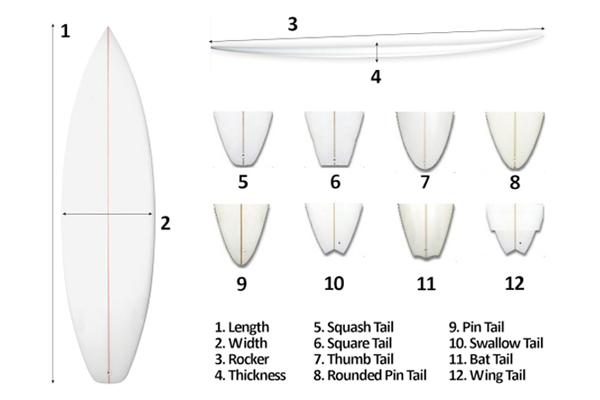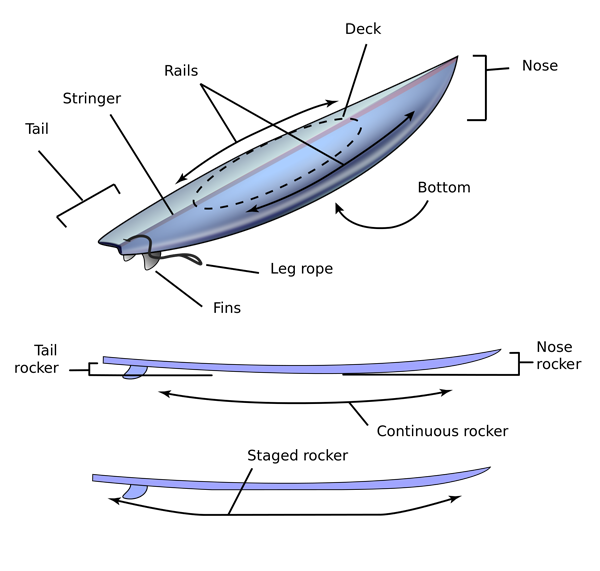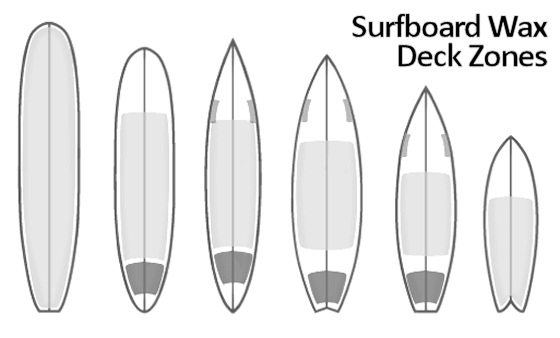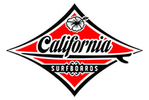- Home
- Surfboards
- Surfboards 101 - Help Index
Surfboards 101 - Help Index

Design
Surfboard design is the art of shaping a surfboard from a foam (or wood) blank and making it into a vehicle for riding waves via research and development in and out of the water. The finished surfboard design is radically different from the crude materials it started as before a shaper begins to form the board. Since surfboards are ridden at beaches all over the world a designer must create a board that will work well in specific conditions.
In order to make the best surfboards, shapers and designers spend countless hours honing their craft, becoming better surfboard builder’s one board at a time. Luckily for us, their passion and commitment result in surfboards that will enhance our skills and increase enjoyment in the water. Here are some of the elements a surfboard shaper/designer keeps in mind while designing a new board.
The three main aspects of surfboard design are:
1. Components of a surfboard
2. Types of surfboards
3. Materials used in surfboards
1. Components of a Surfboard
Length – This is the measurement of a surfboard from nose to tail. A longer surfboard will offer more paddling power and stability. The large surface area allows the surfer to paddle faster and get into larger waves. Most shapers will want to know the surfer’s weight and ability before suggesting the right size board. (Cal Surf recommends a longer board 7’6+ for people just starting out).
Width – This is the measurement of a surfboard at its widest point. A wider shape will allow the surfer to eliminate a few inches of length without sacrificing paddling or planning speed. The location of the surfboard’s wide point deserves careful consideration as it will affect riding style and turning radius. Whether you are a back-foot or a front-foot surfer, it’s all about how you want to surf. If you want to aggressively attack a wave’s lip and apply more force to your surfboard’s fins to blow the fins out the back and get more spray, then you need a shape that will accommodate vertical, pivotal, back-footed surfing. If you’re more interested in drawing long lines in a wave and taking a smoother arc at the wave’s lip, then a front-footed surfboard is more for you. If both sound appealing, then pick a board model that has the best of both worlds with your next custom surfboard.
Nose – This is the front tip of the surfboard. The shape will affect entry into the wave, paddling ability, and nose riding. Noses will vary in width, curvature and thickness. There are three basic types of surfboard nose:
Pointed Nose
Most high performance boards, like thrusters, have a pointed nose. The pointed shape adds more rail curve to the plan shape when compared to a round nose longboard. This comes in handy when the head of the board is digging into the water, as when dropping into a steeper waves, to help keep the board from pearling. Because there is less volume, it is easier to duck dive a wave where as a round nose requires a lot more force to shovel the nose under water.
Hybrid Point Nose
This is a middle ground point between the transition shape between a pointed nose and full round nose. The little extra volume in the front helps make catching waves easier. While not being fully round maneuvering the surfboard is made easier as well.
Rounded Point Nose
This is a transition shape between a pointed nose and full round nose. The extra volume in the front helps make catching waves and balancing easier. They are a little harder to maneuver however so keep that in mind when you are looking for a surfboard.
Round Nose
This shape allows for the front of the board to have more surface area, giving the board more stability. Longboards typically have a round nose for the purpose of allowing the surfer to nose-ride. Round nose boards make it easier to paddle, glide, and plane on the surface because it helps to keep more of the surfer out of the water.
Nose Riding Nose
Some surfboards come with a nose designed to be ridden on. Longboards that are ridden on the nose where a surfer dangles one or both feet over the front of the surfboard. These noses tend to be thicker to support the additional weight.
Tail – The surfboard tail is the back end of the surfboard. Its design significantly affects the performance of the finished product. It has various shapes, performance characteristics, and rockers. Some examples are: square, pin, swallow, diamond and squash.
Basic Tail Shapes
When looking at different tails, a good rule to remember is more angular shapes will give you more pivotal and sharper turns. A rounder shaped tail will give you rounder and smoother turns. Tail shape influences the hold and release on the surface of the wave. Picture how water flows off the back of the board. Water is sticky and follows the lines of the board. Curves hold water flow whereas corners allow water to break away. A round or pin tail will hold the water longer making it stable in bigger surf. A square or angular tail will release water making it looser, skatier and snappy.
Different shapes will change the width of the tail, which determines surface area. This will influence how your acceleration and how much control you have on the face of the waves. Although there is a wide spectrum of tail shapes, most are variations of the following fundamental tail designs.

Basic Tail Shapes
Pin Tail
Pin Tail Surfboard
This is designed for maximum traction and control on the wave. Pin tails have the narrowest width of all the tails. Less width minimizes the tail's surface area allowing you to sink and dig into the water causing the board to track and maintain direction. Notice the shape is a straighter curved line that converges to a point, thus called the pin tail. This design gives you maximum water flow without any abrupt release for better hold. Pintails can be difficult to maneuver and are not ideal for small waves where tail surface area is needed for lift. That is why you typically find these pin tails on gun surfboards. When you're dropping into a large wave, tracking and control in high speeds is more important than maneuverability.
Round Tail / Thumb Tail
Round Thumb Tail Surfboard
This shape is similar to a pin tail because it allows water to wrap around its contour for better traction than the square tail in bigger, faster, hollow waves. It is more versatile with more width than the pin tail. The added width increases the surface area and results in more lift. More lift allows the board to be more loser and turn-able than its pin tail counterpart. With the curve shape you should expect more round, drawn out turns and less sharp pivotal turns than its square tail counterpart. The added surface area will also provide more speed in slow spots.
Squash Tail
Squash Tail Surfboard
The most common tail among shortboards is a squash tail, which is a variation of the square tail. The square or edgier shape allows for quick release. This makes the board very responsive and easier for sharper and looser turns. The shape allows for more width, which increases the surface area in the tail. More surface area means more lift, or easier to plane and maintain speed. This will obviously come in handy in the slower spots of a wave. Less surface area will cause the tail to sink or bite into the wave, making it ideal for control and tracking in high speeds. The rounded ends give the board more hold than a hard edge square tail. A squash tail is very versatile as it is designed to give you better control in steeper and bigger waves as well as softer waves.
Swallow Tail
Swallow Tail Surfboard
Notice the shape of a swallow tail resembles two miniature pin tails joined together side-by-side. Its design is similar to the pintail in that the two points will give the board more hold and traction. The upside down vee that is cut out of the tail allows for bite and control when the board is going in and out of turns. Notice the shape allows for a much wider tail and larger surface area, making it easier to maintain speeds in softer parts of the wave. This is more ideal for smaller waves, which is why a fish will typically have a very pronounced swallow tail. The wider and more pronounced the swallow tail, the stiffer it is in transition from rail to rail. When making radical changes in direction, the pin of one side has to disengage before the tail can reengage on the other pin to pivot.
Bat Tail / Diamond Tail
Bat tail or Diamond tails are similar to the pintail in that the three points will give the board more hold and traction. The upside down vee that is cut out of the tail allows for bite and control when the board is going in and out of turns. The shape allows for a much wider tail and larger surface area, making it easier to maintain speeds in softer parts of the wave. This is more ideal for smaller waves, which is why a bat fish or Diamond tail will typically have a very pronounced tail. The wider and more pronounced the tail, the stiffer it is in transition from rail to rail. When making radical changes in direction, the pin of one side has to disengage before the tail can reengage on the other pin to pivot. The wider and more pronounced the tail, the stiffer it is in transition from rail to rail. When making radical changes in direction, the pin of one side has to disengage before the tail can reengage on the other pin to pivot.
Square Tail
Square Tail Surfboard
The square tail is the earliest surfboard tail design and the parent of all other tail designs. The square tail is wide and helps ad stability to a surfboard. Because of the extra width in the tail though, the surfboard will have less curve in the rails. The corners of a square tail dig into a wave while turning and help increase the ability of a surfboard to make pivotal turns. You will most often see a square tail on a longboard, though some shortboards have a smaller version.
Rocker – This is the curvature of the surfboard profile. The foam blank comes with a particular rocker that the shaper can alter a bit, but not drastically. A more dramatic rocker will make it easier to handle steep drops, facilitate tighter turns, but also slow the board down if it is heading in a straight line. The rocker is the bottom curve of the board from the nose to the tail. It is the curvature of the surfboard from a profile or side angle. The basic reason for this curve is to fit the surface area of the board to the curvature of a wave face. If your surfboard had a straight rocker, you are more likely to pearl when dropping into the steep part of the wave.
The amount of curve in the rocker will affect the turning or carving ability of the board. Performance shortboards typically have more rocker to give a smaller turning radius. It is also more suitable for getting into steep and hollow waves. Surfboards with low rocker keep more surface area on top of the water, allowing the rider to generate more speed when paddling and surfing. This is in contrast to boards with more rocker, which have less surface area on the water and, thus, do not pick up speed as easily. Longboards are designed to catch waves with ease and typically have lower rocker than shortboards. The low rocker makes longboards more suitable for slow, mushy waves as opposed to steep hollow waves.
Nose Rocker
The nose rocker is curved near the front of the board. Similar to the front of a boat’s hull, this is designed to keep you from digging into the bumps of the wave. As a surfer drops into a wave, the curvature of the nose will help to keep the board on top of the wave’s surface. Otherwise, the board's nose may dig into the water and pearl.
Tail Rocker
The bottom curve at the back end of the board is designed for tail kick. With more tail curve, the easier the board squats. This loosens the board up to change directions and making more pivotal turns. Tail kick also makes it easier to drop into waves without pearling because the upwards lift of the tail isn’t forcing the nose downwards as much as a straight tail rocker would.
While a board with more tail rocker will offer increased control, this design will slow the board down. The less curve in the tail rocker, the easier the board will plane, making the board faster.
Rails – These are the outer edges of the surfboard. They impact tube riding, planing speed, and turning.
Fins – Surfboard fins are the engines that make sure your board moves forward. They dictate turning radius, drive, hold in a wave’s face, drag vs. speed, and overall performance. Typical setups are single fin, twin fin, tri fin (thruster), quad fin, and the rarely seen five-fin setup.
Bottom Contour – The surfboard bottom contour contributes to the speed, turning ability, and style of ride. A convex bottom, sometimes called a hull, will sit low in the wave, move slowly, and offer the surfer a smooth ride. A concave bottom will skip on top of the water, creating lift and shooting water out the back of the board toward the fins. This makes for a very fast and maneuverable ride. Concave designs will vary.
The bottom contour of the surfboard is designed to channel water for the purpose of stability, maneuverability, and speed. By directing water flow through the length of the board, the bottom contour will affect the board's performance. There is a wide array of different bottom contours, but the following are the fundamental shapes.
Flat bottom
A flat bottom surfboard has a flat planing surface. The design is efficient for planing on top of the water. It slaps the wave rather than parting the water. The board is quick, loose and responsive in small and mushy waves. However, they are more unstable in bigger waves and at higher speeds. The flatness will make it difficult to initiate turns and will frequently slide out when turned hard.
Belly Bottom
The belly has a convex planing surface typically found towards the front 1/3 of the board. Unlike a flat bottom which slaps the wave’s surface, the convex surface parts the water. This is designed for control. It gives it a smoother ride in choppy conditions. In big and fast surf, it makes it easier to roll which means it is easier to lean from rail to rail. This is essential for controlling your board at high speeds. The design is useful in bigger surf, where speed is not an issue and control is more important. The downside is the surface's inefficiency. Energy is lost when water is parted and escapes from the rails, which slows the board. This forces the board to work harder to move because it has to plow through water rather than skimming on top of it.
Concave Bottom
This is a concave planing surface. The purpose for this shape is to contain water flow through the length of the board rather than allowing the water to release from the rails. From the wide point of the board to the narrow end of the board’s tail, the water is squeezed out through to the fins, otherwise known as the aft section of the board. The increase pressure from water flow causes more lift and less drag. By compressing the water and squeezing it out towards the tail of the board, it accentuates the acceleration of the surfboard through turns as well. This shape does not perform well in choppy conditions.
Channel Bottom
This shape consists of multiple concaved grooves underneath the tail section of the board. They can be anywhere from 2 to 8 channels that run parallel to each other. The channels propel more water through the board, converting the water flow into forward thrust.
Vee Bottom
The Vee is also a convex planing surface typically located towards the back 1/3 of the board. Similar to the belly bottom shape, it acts as a pivot point for rail to rail surfing. Because the shape is used towards the tail of the board, this helps to make the tail area more responsive at high speeds. Like any convex planing surface, energy is lost as water parts and escapes from the rails making it inefficient in smaller or mushier waves. The shape is suitable in big and fast waves where control is needed more than speed. 
Foil – Foil refers to the distribution of surfboard foam from nose to tail. The thickness of the nose, middle, and tail weigh heavily in the overall performance of the surfboard.
Deck – The deck is the top of the surfboard. The surfboard rails often impact the deck design. The most common are domed, flat, and step decks. Each has its own benefits, performance characteristics, and feel.
2. Types of Surfboards
Shortboards – This surfboard design had great success with high performance surfing in the 1970s and still allows surfers to push the boundaries of their ability. The modern shortboard is typically under seven feet long and is made for aggressive surfing in critical sections of the wave. It is most commonly seen with sharp noses, thinner rails, and high rocker which produce high levels of maneuverability.
Check Out the Cal Surf Shortboard Models - The Tool - Whip Stick - The-Bomb
Groveler/Fun – These terms describe a larger surfboard shape with a lot of volume. They range in length from 6 feet to 8 feet. The fun board or "groveler" is a great transitional board for anyone who wants to move down in size while still maintaining superior paddling power and stability. Because “fun boards” are wider, they allow the rider to balance easily, which makes them fun to ride, especially for beginners. The fun board or "groveler" will come in various tail shapes, nose shapes, and foils.
Check Out the Cal Surf Fun Board Models - Wizard Wand - PLB - Toe Stub
Fish – This board design gained popularity in the 1970s and originates from the knee-board. It is shorter, wider and flatter than a shortboard and works very well in small mushy surf. There is not much curve in the rocker of a fish, which makes it paddle very well and carry speed through flat sections of the wave.
Check Out the Cal Surf Fish Surfboard Models - Fish Stick - Bat Fish
Hybrid – The hybrid surfboard design mixes the design features from two similar board types. One example is the hybrid fish which mixes the characteristics and performance of a shortboard design with the added width and tail design of a fish. This is a great board for a heavier surfer who wants to surf at a high level or anyone else who wants to catch a lot of waves.
Check Out the Cal Surf Hybrid Surfboard Models - Cal Surf Rocket - Fish Stick - Bat Fish - Toe Stub - Speed Demon
Longboard – A classic longboard is the most traditional surfboard shape. Longboards were what surfers in Malibu, California & Hawaii originally rode in the 1950's & 1960's. They typically range from 8 feet to 12 feet in length. They are on average at least 2.5 inches thick & twenty inches wide. The fact that they are thicker allows them to paddle incredibly well. Someone learning to surf should start on a longboard shape to learn wave selection, paddling technique, and turning basics. Expert longboarders are the masters of style, surfing in a flowing and visually appealing manner.
Check Out the Cal Surf Longboard Models - Wizard Wand - PLB - Heck Of A Longboard - The Wizard
3. Materials Used In Surfboards
Foam Blank – Almost 100% of surfboards in the lineup today are made with polyurethane or polystyrene (Styrofoam) cores. The foam blank arrives to the shaper in the crude outline of a surfboard shape, including varying degrees of rocker. Your shaper then starts “mowing foam” as he shaves off the excess foam until he arrives at the shape of your next surfboard. Two forms of Polystyrene are the most common: Expanded Polystyrene (EPS) and Extruded Polystyrene (XPS).
Fiberglass cloth - A shaped foam blank is too weak and porous to use in the water on its own. To strengthen the surfboard a layer or two of fiberglass cloth is applied to the entire length and width of the surfboard, both deck and bottom. The most common fiberglass used is 4oz and 6oz cloth. Shapers have started using alternative materials to strengthen a surfboard, such as Kevlar and carbon fiber or natural materials like hemp based cloth.
Resin – The glasser must use a resin to bond the cloth to the shaped foam surfboard design. The resin is poured onto the cloth and the board until the cloth is completely saturated. The polyester resin has been used since the 1950s and is still the most commonly used today. Epoxy resin has gained popularity over the last several years due to its increased strength and ability to create lighter boards. Both epoxy and polyester resin may be used with polyurethane foam, but only epoxy may be used with polystyrene foam. Polyester will destroy the polystyrene structure at the point of contact.
Some epoxy surfboards have a plastic look. These boards do not allow you to see the foam blank, the fiberglass cloth, or the stringer beneath the exterior. They are built with what is called a sandwich construction in which the shell is made and then filled with foam. They tend to be stronger and better at resisting pressure dings that form by standing on the deck, though the material also has an effect on the flex pattern.
Stringer - This wood structure typically runs down the center of a foam blank. It provides strength and flex memory for the surfboard. Some shapers will move the wood stringer from the board’s center to its rails, creating better flex memory. Common wood types used in stringers are bamboo, balsa, Basswood, Western Red Cedar, and Engelmann Spruce.

Now that you know a lot more about boards and the way they are made, it is time to wax up and surf. Design your custom California Surfboard right online in front of your eyes at a reasonable fair price now.
Check Out the Cal Surf Surfboard Models
 Loading... Please wait...
Loading... Please wait...

